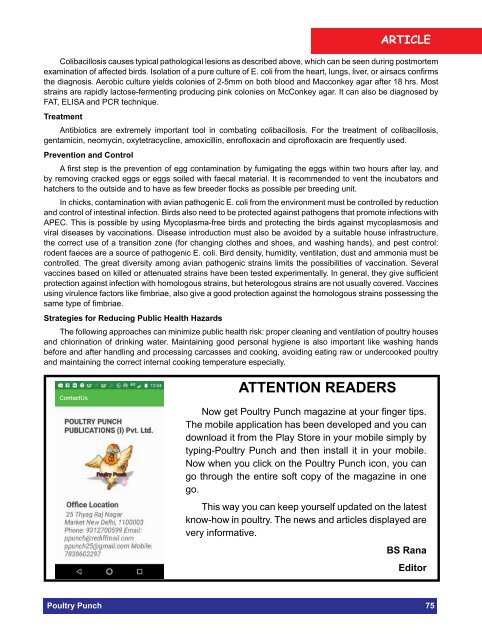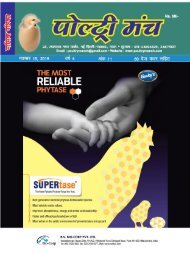November 2018 Punch PDF
Create successful ePaper yourself
Turn your PDF publications into a flip-book with our unique Google optimized e-Paper software.
Colibacillosis causes typical pathological lesions as described above, which can be seen during postmortem<br />
examination of affected birds. Isolation of a pure culture of E. coli from the heart, lungs, liver, or airsacs confirms<br />
the diagnosis. Aerobic culture yields colonies of 2-5mm on both blood and Macconkey agar after 18 hrs. Most<br />
strains are rapidly lactose-fermenting producing pink colonies on McConkey agar. It can also be diagnosed by<br />
FAT, ELISA and PCR technique.<br />
Treatment<br />
Antibiotics are extremely important tool in combating colibacillosis. For the treatment of colibacillosis,<br />
gentamicin, neomycin, oxytetracycline, amoxicillin, enrofloxacin and ciprofloxacin are frequently used.<br />
Prevention and Control<br />
A first step is the prevention of egg contamination by fumigating the eggs within two hours after lay, and<br />
by removing cracked eggs or eggs soiled with faecal material. It is recommended to vent the incubators and<br />
hatchers to the outside and to have as few breeder flocks as possible per breeding unit.<br />
In chicks, contamination with avian pathogenic E. coli from the environment must be controlled by reduction<br />
and control of intestinal infection. Birds also need to be protected against pathogens that promote infections with<br />
APEC. This is possible by using Mycoplasma-free birds and protecting the birds against mycoplasmosis and<br />
viral diseases by vaccinations. Disease introduction must also be avoided by a suitable house infrastructure,<br />
the correct use of a transition zone (for changing clothes and shoes, and washing hands), and pest control:<br />
rodent faeces are a source of pathogenic E. coli. Bird density, humidity, ventilation, dust and ammonia must be<br />
controlled. The great diversity among avian pathogenic strains limits the possibilities of vaccination. Several<br />
vaccines based on killed or attenuated strains have been tested experimentally. In general, they give sufficient<br />
protection against infection with homologous strains, but heterologous strains are not usually covered. Vaccines<br />
using virulence factors like fimbriae, also give a good protection against the homologous strains possessing the<br />
same type of fimbriae.<br />
Strategies for Reducing Public Health Hazards<br />
The following approaches can minimize public health risk: proper cleaning and ventilation of poultry houses<br />
and chlorination of drinking water. Maintaining good personal hygiene is also important like washing hands<br />
before and after handling and processing carcasses and cooking, avoiding eating raw or undercooked poultry<br />
and maintaining the correct internal cooking temperature especially.<br />
ATTENTION READERS<br />
ARTICLE<br />
Now get Poultry <strong>Punch</strong> magazine at your finger tips.<br />
The mobile application has been developed and you can<br />
download it from the Play Store in your mobile simply by<br />
typing-Poultry <strong>Punch</strong> and then install it in your mobile.<br />
Now when you click on the Poultry <strong>Punch</strong> icon, you can<br />
go through the entire soft copy of the magazine in one<br />
go.<br />
This way you can keep yourself updated on the latest<br />
know-how in poultry. The news and articles displayed are<br />
very informative.<br />
BS Rana<br />
Editor<br />
Poultry <strong>Punch</strong> 75





